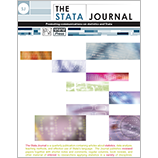The estimation and modeling of cause-specific cumulative incidence functions using time-dependent weights
Paul C. Lambert
Department of Health Sciences
University of Leicester
Leicester, UK
and
Medical Epidemiology and Biostatistics
Karolinska Institutet
Stockholm, Sweden
[email protected]
|
Abstract. Competing risks occur in survival analysis when an individual is at risk of
more than one type of event and one event’s occurrence precludes another’s.
The cause-specific cumulative incidence function (CIF) is a measure of interest
with competing-risks data. It gives the absolute (or crude) risk of having the
event by time t, accounting for the fact that it is impossible to have
the event if a competing event occurs first. The user-written command
stcompet calculates nonparametric estimates of the cause-specific CIF,
and the official Stata command stcrreg fits the Fine and Gray (1999,
Journal of the American Statistical Association 94: 496–509) model
for competing-risks data. Geskus (2011, Biometrics 67: 39–49) has
recently shown that standard software can estimate some of the key measures in
competing risks by restructuring the data and incorporating weights. This has a
number of advantages because any tools developed for standard survival analysis
can then be used to analyze competing-risks data. In this article, I describe
the stcrprep command, which restructures the data and calculates the
appropriate weights. After one uses stcrprep, a number of standard
Stata survival analysis commands can then be used to analyze competing risks.
For example, sts graph, failure will give a plot of the cause-specific
CIF, and stcox will fit the Fine and Gray (1999) proportional subhazards
model. Using stcrprep together with stcox is computationally much
more efficient than using stcrreg. In addition, stcrprep opens
up new opportunities for competing-risk models. I illustrate this by fitting
flexible parametric survival models to the expanded data to directly model the
cause-specific CIF.
View all articles by this author:
Paul C. Lambert
View all articles with these keywords:
stcrprep, survival analysis, competing risks, time-dependent effects
Download citation: BibTeX RIS
Download citation and abstract: BibTeX RIS
|
